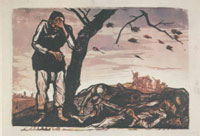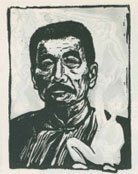Collection Highlights
Kakitsu Uchiyama and Chinese Woodcuts
Woodcuts produced in China in the 1930s and the 1940s are referred to as mokkokuga in Japanese. Kakitsu Uchiyama visited his elder brother Kanzo, who ran a bookstore in China, and held printmaking classes in Shanghai. Through these classes, the Modern Woodcut Movement, which evolved in conjunction with the anti-Japan campaign led by Lu Xun in the 1930s, spread all at once among the young people. Rather than a collector, Uchiyama spent the turbulent years of the Sino-Japanese War together with the younger generation as one of the participants in the movement of the time and brought numerous naïve, powerful prints back to Japan. The exhibition of Chinese woodcuts held out our Museum in 1975 was composed mainly of woodcuts dating from the 1930s to the 1940s, which had been donated to the Museum by Mr. Uchiyama the year before. Thanks to a second donation in 1980, works dating from 1955 to the 1970s were added, making it a collection of altogether 600 Chinese prints. This is an internationally rare collection more or less unparalleled even in China.
-

Wang Renfeng
Funeral
date unknown -

Chen Baozhen
Light Before Your Eyes
circa 1932 -

Shao Keping
Professor Lu Xun
1947

